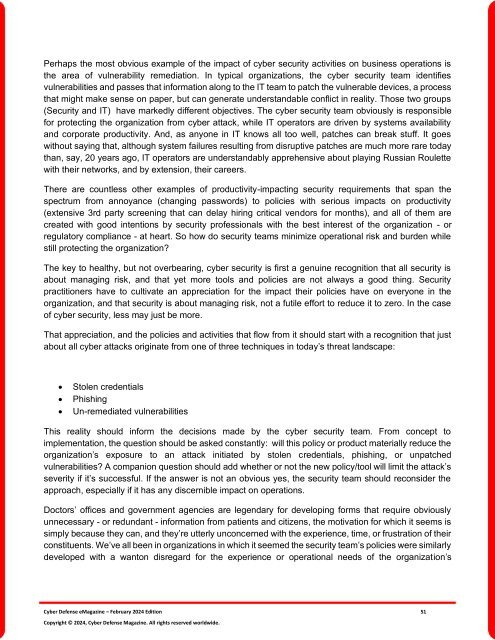The Cyber Defense eMagazine February Edition for 2024
Cyber Defense eMagazine February Edition for 2024 #CDM #CYBERDEFENSEMAG @CyberDefenseMag by @Miliefsky a world-renowned cyber security expert and the Publisher of Cyber Defense Magazine as part of the Cyber Defense Media Group as well as Yan Ross, Editor-in-Chief and many more writers, partners and supporters who make this an awesome publication! 155 page February Edition fully packed with some of our best content. Thank you all and to our readers! OSINT ROCKS! #CDM #CDMG #OSINT #CYBERSECURITY #INFOSEC #BEST #PRACTICES #TIPS #TECHNIQUES
Cyber Defense eMagazine February Edition for 2024 #CDM #CYBERDEFENSEMAG @CyberDefenseMag by @Miliefsky a world-renowned cyber security expert and the Publisher of Cyber Defense Magazine as part of the Cyber Defense Media Group as well as Yan Ross, Editor-in-Chief and many more writers, partners and supporters who make this an awesome publication! 155 page February Edition fully packed with some of our best content. Thank you all and to our readers! OSINT ROCKS! #CDM #CDMG #OSINT #CYBERSECURITY #INFOSEC #BEST #PRACTICES #TIPS #TECHNIQUES
You also want an ePaper? Increase the reach of your titles
YUMPU automatically turns print PDFs into web optimized ePapers that Google loves.
Perhaps the most obvious example of the impact of cyber security activities on business operations is<br />
the area of vulnerability remediation. In typical organizations, the cyber security team identifies<br />
vulnerabilities and passes that in<strong>for</strong>mation along to the IT team to patch the vulnerable devices, a process<br />
that might make sense on paper, but can generate understandable conflict in reality. Those two groups<br />
(Security and IT) have markedly different objectives. <strong>The</strong> cyber security team obviously is responsible<br />
<strong>for</strong> protecting the organization from cyber attack, while IT operators are driven by systems availability<br />
and corporate productivity. And, as anyone in IT knows all too well, patches can break stuff. It goes<br />
without saying that, although system failures resulting from disruptive patches are much more rare today<br />
than, say, 20 years ago, IT operators are understandably apprehensive about playing Russian Roulette<br />
with their networks, and by extension, their careers.<br />
<strong>The</strong>re are countless other examples of productivity-impacting security requirements that span the<br />
spectrum from annoyance (changing passwords) to policies with serious impacts on productivity<br />
(extensive 3rd party screening that can delay hiring critical vendors <strong>for</strong> months), and all of them are<br />
created with good intentions by security professionals with the best interest of the organization - or<br />
regulatory compliance - at heart. So how do security teams minimize operational risk and burden while<br />
still protecting the organization?<br />
<strong>The</strong> key to healthy, but not overbearing, cyber security is first a genuine recognition that all security is<br />
about managing risk, and that yet more tools and policies are not always a good thing. Security<br />
practitioners have to cultivate an appreciation <strong>for</strong> the impact their policies have on everyone in the<br />
organization, and that security is about managing risk, not a futile ef<strong>for</strong>t to reduce it to zero. In the case<br />
of cyber security, less may just be more.<br />
That appreciation, and the policies and activities that flow from it should start with a recognition that just<br />
about all cyber attacks originate from one of three techniques in today’s threat landscape:<br />
• Stolen credentials<br />
• Phishing<br />
• Un-remediated vulnerabilities<br />
This reality should in<strong>for</strong>m the decisions made by the cyber security team. From concept to<br />
implementation, the question should be asked constantly: will this policy or product materially reduce the<br />
organization’s exposure to an attack initiated by stolen credentials, phishing, or unpatched<br />
vulnerabilities? A companion question should add whether or not the new policy/tool will limit the attack’s<br />
severity if it’s successful. If the answer is not an obvious yes, the security team should reconsider the<br />
approach, especially if it has any discernible impact on operations.<br />
Doctors’ offices and government agencies are legendary <strong>for</strong> developing <strong>for</strong>ms that require obviously<br />
unnecessary - or redundant - in<strong>for</strong>mation from patients and citizens, the motivation <strong>for</strong> which it seems is<br />
simply because they can, and they’re utterly unconcerned with the experience, time, or frustration of their<br />
constituents. We’ve all been in organizations in which it seemed the security team’s policies were similarly<br />
developed with a wanton disregard <strong>for</strong> the experience or operational needs of the organization’s<br />
<strong>Cyber</strong> <strong>Defense</strong> <strong>eMagazine</strong> – <strong>February</strong> <strong>2024</strong> <strong>Edition</strong> 51<br />
Copyright © <strong>2024</strong>, <strong>Cyber</strong> <strong>Defense</strong> Magazine. All rights reserved worldwide.

















